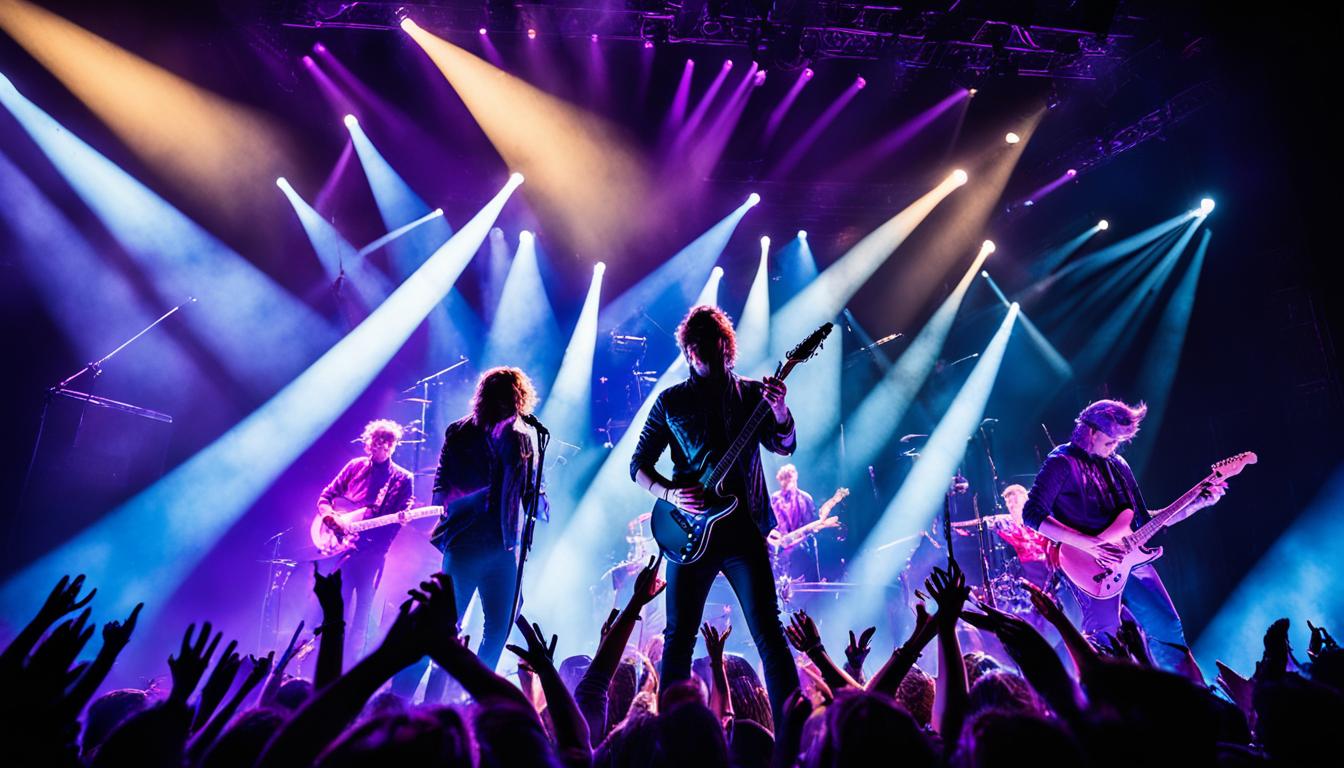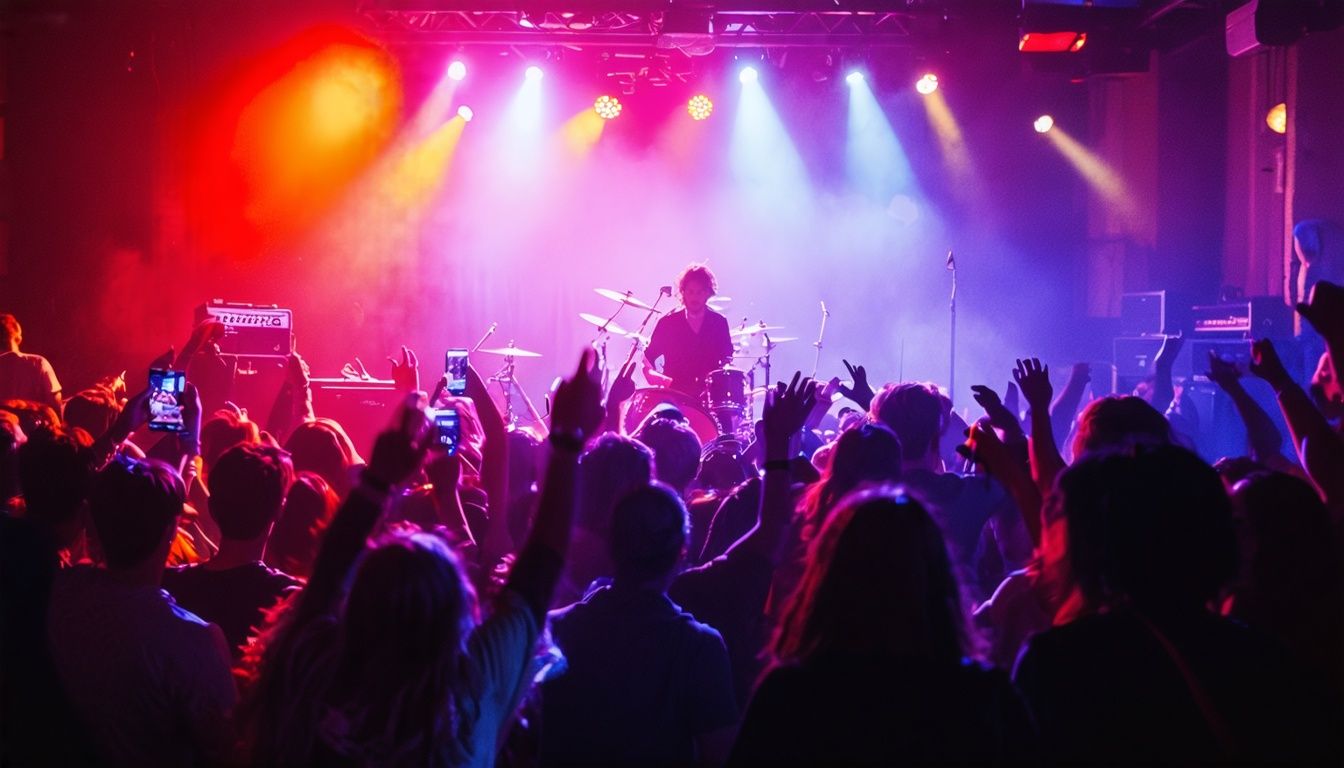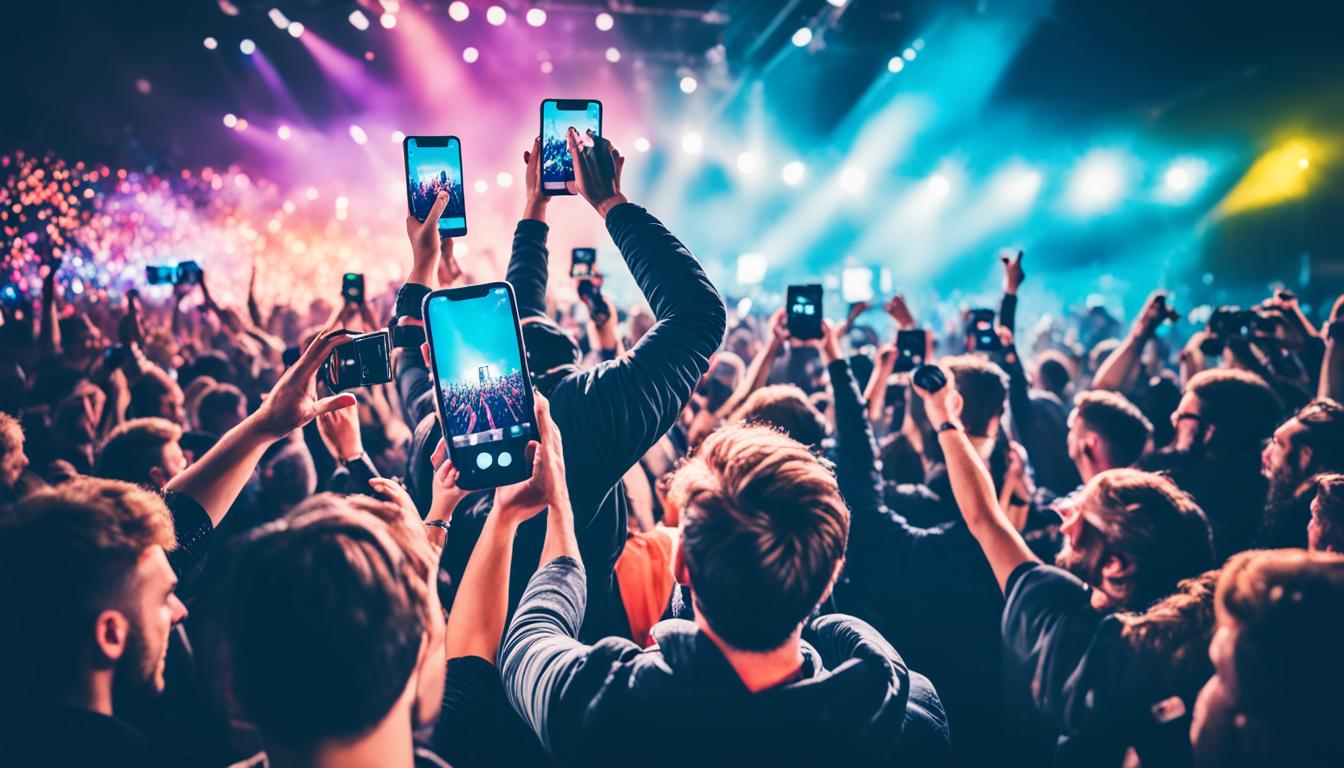When we step into concert photography, a world full of lights and colors greets us. It’s not just about changing camera settings for the bright scenes. We aim to help you use lighting in ways that capture live music’s essence.
Finding the perfect shot often starts with prep work and knowing your lighting gear. Concert lights can be tough to work with. Yet, with smart strategies, these issues become chances for stunning photos. We’ll show you how creative lighting brings concert scenes to life, just like the live shows.
Key Takeaways
- Understanding and adapting to the dynamic lighting at concerts.
- Preparing a versatile concert photography lighting setup.
- Employing creative approaches to combat and utilize challenging lighting situations.
- Using advanced lighting techniques to emphasize the energy of live performances.
- Continuous learning and experimentation to refine concert photography skills.
Understanding the Intricacies of Concert Lighting
As we dive into concert photography for beginners, we see the key role of stage lighting. It’s vital for capturing the atmosphere of live shows. Both beginners and professionals must understand light’s effect on their photos.
The Impact of Varied Lighting Conditions on Photography
Varying lights set the mood and scene for memorable photos. Spotlights highlight solo artists, creating dramatic effects. Strobes and lasers fill the stage with vibrant colors and movement. We must stay ready to capture these fleeting moments.
Adjusting Camera Settings to Navigate Complex Lighting
Choosing the right camera settings is a mix of skill and creativity. Balancing ISO, aperture, and shutter speed is crucial. We often increase ISO for low light, adjust aperture for the best light capture, and manage shutter speeds to avoid blurs.
Learning the Venue’s Lighting Setup Before the Show
Knowing the event’s lighting setup helps us plan our shots. Talking to lighting engineers or studying past events offers valuable insights. This preparation allows us to be strategic with our positions and shots.
Stage lighting adds life to our photographs. It’s our job to capture this moving light in still images. These pictures stay vibrant, even after the concert ends.
Camera Settings Cheat Sheet for Concert Environments:
| Lighting Scenario | ISO Range | Aperture | Shutter Speed |
|---|---|---|---|
| Dimly Lit Stage | 3200-6400 | f/2.8 – f/4 | 1/60 – 1/125 sec |
| Brightly Lit Performer | 1600-3200 | f/4 – f/5.6 | 1/250 – 1/500 sec |
| Colorful Lighting Effects | 1600-3200 | f/2.8 – f/4 | 1/125 – 1/250 sec |
| Flashing Strobes | 800-1600 | f/5.6 – f/8 | 1/500 – 1/1000 sec |
These settings are just starting points. Each concert is unique, requiring us to adjust our cameras to the show’s rhythm. But remember, capturing the magic of concerts is all about understanding light.
Handling Low Light Challenges in Concert Photography
In concert photography, dealing with low light is a big challenge. To capture the energy of a live performance, knowing how to work with concert photography lighting setup in low light situations is key. We use a special lens for concert photography designed for low light. This helps us keep the moment’s true vibe without losing quality.
Choosing the right lens is important, and it has to let in lots of light. We prefer lenses that open to f/1.8 or f/2.8. These let in the most light and keep our photos from getting too grainy. Using these fast lenses helps us capture every detail and color vividly.
- Lens with f/1.8 aperture – Excellent in ultra-low light
- Lens with f/2.8 aperture – Versatile for various lighting conditions
But, even the best lenses might not stop grainy images entirely. So, we also use a photo noise reduction technique after taking the photos. This step improves the photos’ quality. It also keeps them feeling real and full of life, like the music itself.
We believe in letting the music guide our lens, our intuition aligned with the rhythm to find clarity amidst shadows and highlights.
For editing, we often use Luminar Neo. It’s great for fine-tuning photos to show off the event’s light and colors. The software’s strong features for reducing noise help us make each photo sharp and vibrant. We view editing as a way to make our photos as impactful as the music.
Low light photography at concerts is challenging, but it makes us better photographers. These challenges encourage us to be more creative. With the right lens and editing techniques, we turn difficult situations into chances for amazing photos. These images leave a lasting impression, just like the music.
Advanced Lighting Techniques for Concert Photography
In concert photography, learning advanced lighting techniques is key. We aim for iconic shots that show the live performance’s spirit. We explore manual mode and different lenses to control our settings. This way, we capture the moment’s energy accurately.

Mastering Manual Mode for Precise Control
Using manual mode lets us fully control our camera settings. It’s crucial for managing concert photography’s tricky lighting. We adjust ISO, aperture, and shutter speeds carefully. Our goal? To make each photo clear and deep. This approach is both a science and an art, letting us leave our mark on every shot.
Choosing the Right Lenses for Low-Light Excellence
Finding the right lens makes a huge difference under low light. Prime lenses are great for their wide apertures and sharp images in the dark. Zoom lenses, meanwhile, offer flexibility. They let us go from close-ups to wide shots without moving. Balancing between prime and zoom lenses is essential for our photography.
Strategies for Capturing Dynamic Stage Performances
Concerts are unpredictable and full of life. To capture this, we need a plan that’s flexible and quick. We might capture a fast-moving moment or a powerful, quiet one. Using quick shutter speeds and knowing our settings help us catch the peak moments. Immersing ourselves in the show’s rhythm, we create photos that move people.
Capturing the Energy: Techniques for Conveying Motion
Diving into concert photography, we see it’s more than catching action. It’s about showing the joy of performances. Concert photography settings help us capture motion blur. This makes the artist’s movements look sharp and full of energy. It’s like a dance between the musician’s moves and our quick shots.
Using burst mode photography is key to showing the concert’s vibe. It lets us take many photos quickly. This increases our chances of getting that perfect shot. The right mix of expression, composition, and motion comes alive, especially with dramatic lights.
Understanding the concert’s rhythm helps us get great photos of fast-paced action. By knowing the artist’s next move, we can be ready. We can turn motion blur into an art. It shows the speed and power of the performance in our photos.

Fast shutter speeds help us cut through action blur. We set our cameras faster than 1/250th of a second. This captures clear moments that would otherwise look blurred. For very fast movements, we need even faster shutter speeds.
Mastering concert photography settings also means understanding light. Watching how light plays with movement guides our shots. It helps us capture moments that are sharp and full of the music’s power. The changing lights are our allies in telling stories with our photos. We capture the concert’s energy in these moments.
Post-Processing and Editing: Perfecting Your Concert Shots
After the concert, we head to the digital darkroom. This is where post-processing concert photographs starts. It’s not just about taking the photo. It’s about making it stand out with skilled editing.
How do we begin? By learning how to use our editing tools for photography. We start with basic adjustments like exposure and white balance. Next, we make the scene inviting with color grading. This process isn’t just about bright colors. It reflects the feelings and atmosphere of the concert.
Noise often shows up in low-light concert photos. It’s crucial to reduce it without making photos look fake. We aim to keep the photos clear but still retain their authentic feel. This balance enhances the photo’s quality.
AI-driven adjustments bring new possibilities. These tools can spot changes we might miss. They automatically fix issues like exposure and alignment. This helps each photo show its true story with a few clicks.
Sometimes, black and white photos best capture a concert’s raw emotion. Removing color highlights the performance’s soul. It lets the audience focus on the emotion without color distractions.
To really make these edits work, start with the best photos possible. Know your gear, the setting, and the moment. Together, we turn fleeting moments into unforgettable images. We keep advancing concert photography with our expertise.
Conclusion
In the world of concert photography, we face many tough challenges. These challenges help us grow in creativity and skill. Techniques in concert photography are more than just tools. They are like paintbrushes that let us capture the live music’s raw energy. We aim for the perfect shot, matching our pace with the concert’s rhythm, and catching brief moments of magic.
This journey shows the importance of professional concert photography lighting. Shadows and light play big roles in our stories. We’ve learned a lot about needing innovative concert photography lighting and the right camera settings. We want to make sure we preserve the concert’s unique feel. These methods help us capture the essence of the concert. We turn the vibrant live show into a picture that feels alive and timeless.
Our goal is to bring the stage’s unscripted drama to life, making viewers feel the performance’s heartbeats. Each photo we take makes our stories more interesting, our experiences richer, and our work more colorful. We mix skill with creativity to create images that reflect the true spirit of concert photography. This journey is ongoing, a dedication to the genuine soul of live music, captured one photo at a time.
FAQ
What are some advanced lighting techniques for concert photography?
Advanced techniques involve understanding the venue’s lighting. This includes mastering manual camera settings like ISO, shutter speed, and aperture. Using fast lenses for low-light is key.
Anticipating the action helps capture dynamic performances. Employing burst mode freezes motion in high-energy moments.
How do I adjust my camera settings for complex concert lighting?
Start by using manual mode for control over your camera. Adjust ISO for low light but watch for noise. A wide aperture lets in more light, and a fast shutter speed captures clear images.
Balance settings as stage lighting changes.
How important is it to learn the venue’s lighting setup before a concert?
Knowing the venue’s lighting setup is crucial. It shapes your approach to shooting. This knowledge helps anticipate lighting changes, making decisions about camera settings easier.
What lenses should I use for low-light concert photography?
Choose lenses with wide apertures, like f/1.8 or f/2.8. They allow more light into your camera, reducing grain. Fast lenses are best for the low-light conditions in concerts.
How can I capture the dynamic movements of performers on stage?
Use fast shutter speeds, at least 1/250th of a second, to freeze motion. Continuous or burst mode increases chances of catching peak action moments.
What’s the role of post-processing in concert photography?
Post-processing refines your photos. Adjust exposure, contrast, and balance while reducing noise. Good editing turns a good photo into a great one, capturing the concert’s energy.
What strategies can I use for capturing dynamic stage performances?
Position yourself to catch the action, using fast shutter speeds and continuous mode. Timing shots to music captures expressive moments.
Can AI-driven adjustments improve my concert photography in post-processing?
Yes, AI-driven adjustments in tools like Luminar Neo can improve your photos. They offer noise reduction, enhancements, and creative filters, making editing easier.
What are some creative lighting setups for concert photography?
Use off-camera flashes with gels for color effects. Try long exposures for light trails. Silhouettes create dramatic shots by positioning performers against light sources.



